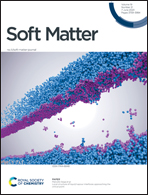Probing the tightly bound layer in poly(vinyl alcohol) thin films using swelling measurements†
Abstract
A strongly adsorbed, tightly bound polymer layer can exist at the polymer/substrate interface in polymer thin films and polymer nanocomposites. The characteristics of the tightly bound layer have long been of interest because of its effect on physical properties. However, direct investigations are challenging as the layer is buried deep within the sample. A common approach to access the tightly bound layer is by rinsing or washing away the loosely bound polymer using a good solvent. While this enables direct investigations of the tightly bound layer, it is unclear if the layer remains unperturbed by the preparation process. Therefore, in situ techniques that can probe the tightly bound layer without strongly perturbing it are preferable. In previous work (P. D. Lairenjam, S. K. Sukumaran and D. K. Satapathy, Macromolecules, 2021, 54, 10931–10942), we introduced an approach to estimate the thickness of the tightly bound layer at the chitosan/silicon interface using swelling of nanoscale thin films when exposed to solvent vapour. To determine the general validity of the approach, in this work we investigated the swelling of poly(vinyl alcohol) (PVA) thin films using two independent techniques: spectroscopic ellipsometry and X-ray reflectivity. We found that the swelling kinetics for thin films of initial thickness in the range 18–215 nm could be described by a single time-dependent swelling ratio, c(t), provided we account for a tightly bound layer of thickness 15 nm at the polymer/substrate interface. Consistent with the conclusions from the swelling measurements, electron density profiles determined by modeling X-ray reflectivity data clearly indicated the existence at the polymer/substrate interface of a 15 nm thick layer of a slightly higher density than the rest of the film. The early-time diffusion coefficient of H2O in PVA determined from the temporal evolution of the mass uptake of the solvent vapour was found to decrease by 3–4 orders of magnitude when the film thickness decreased by approximately an order of magnitude.



 Please wait while we load your content...
Please wait while we load your content...